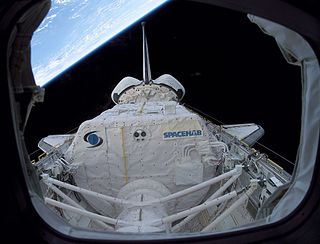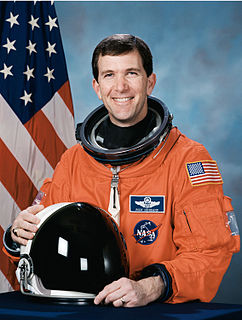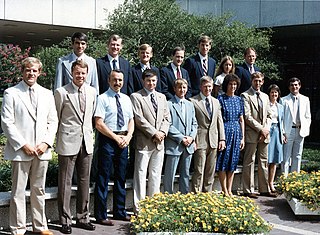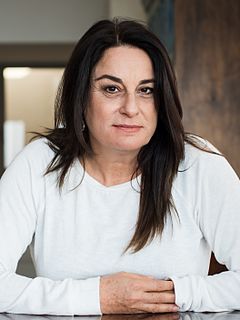
Space Shuttle Challenger (OV-099) was a Space Shuttle orbiter manufactured by Rockwell International and operated by NASA. Named after the commanding ship of a nineteenth-century scientific expedition that traveled the world, Challenger was the second Space Shuttle orbiter to fly into space after Columbia, and launched on its maiden flight in April 1983. It was destroyed in January 1986 soon after launch in an accident that killed all seven crewmembers aboard. Initially manufactured as a test article not intended for spaceflight, it was utilized for ground testing of the Space Shuttle orbiter's structural design. However, after NASA found that their original plan to upgrade Enterprise for spaceflight would be more expensive than upgrading Challenger, the orbiter was pressed into operational service in the Space Shuttle program. Lessons learned from the first orbital flights of Columbia led to Challenger's design possessing fewer thermal protection system tiles and a lighter fuselage and wings. This led to it being 1,000 kilograms lighter than Columbia, though still 2,600 kilograms heavier than Discovery.

Space Shuttle Columbia (OV-102) was a Space Shuttle orbiter manufactured by Rockwell International and operated by NASA. Named after the first American ship to circumnavigate the upper North American Pacific coast and the female personification of the United States, Columbia was the first of five Space Shuttle orbiters to fly in space, debuting the Space Shuttle launch vehicle on its maiden flight in April 1981. As only the second full-scale orbiter to be manufactured after the Approach and Landing Test vehicle Enterprise, Columbia retained unique features indicative of its experimental design compared to later orbiters, such as test instrumentation and distinctive black chines. In addition to a heavier fuselage and the retention of an internal airlock throughout its lifetime, these made Columbia the heaviest of the five spacefaring orbiters; around 1,000 kilograms heavier than Challenger and 3,600 kilograms heavier than Endeavour. Columbia also carried ejection seats based on those from the SR-71 during its first six flights until 1983, and from 1986 onwards carried an external imaging pod on its vertical stabilizer.

STS-107 was the 113th flight of the Space Shuttle program, and the 28th and final flight of Space Shuttle Columbia. The mission launched from Kennedy Space Center in Florida on January 16, 2003, and during its 15 days, 22 hours, 20 minutes, 32 seconds in orbit conducted a multitude of international scientific experiments. It was also the 88th post-Challenger disaster mission.

Ilan Ramon was an Israeli fighter pilot and later the first Israeli astronaut. Ramon was a Space Shuttle payload specialist of STS-107, the fatal mission of Columbia, in which he and the six other crew members were killed when the spacecraft disintegrated during re-entry. At 48, he was the oldest member of the crew. Ramon is the only foreign recipient of the United States Congressional Space Medal of Honor, which he was awarded posthumously.

Kalpana Chawla was an Indian-born American astronaut and mechanical engineer who was the first woman of Indian origin to go to space. She first flew on Space Shuttle Columbia in 1997 as a mission specialist and primary robotic arm operator.

The Space Shuttle Columbia disaster was a fatal accident in the United States space program that occurred on February 1, 2003. During the STS-107 mission, Space Shuttle Columbia disintegrated as it reentered the atmosphere over Texas, killing all seven astronauts on board. The mission was the second that ended in disaster in the Space Shuttle program after the loss of Challenger and all seven crew members during ascent.

Richard Douglas Husband was an American astronaut and fighter pilot. He traveled into space twice: as Pilot of STS-96 and Commander of STS-107. He and the rest of the crew of STS-107 were killed when Columbia disintegrated during reentry into the Earth's atmosphere. Husband is a recipient of the Congressional Space Medal of Honor.

Barbara Radding Morgan is an American teacher and a former NASA astronaut. She participated in the Teacher in Space program as backup to Christa McAuliffe for the 1986 ill-fated STS-51-L mission of the Space Shuttle Challenger. She then trained as a Mission Specialist, and flew on STS-118 in August 2007. She is the first teacher to have been to space.

STS-61-C was the 24th mission of NASA's Space Shuttle program, and the seventh mission of Space Shuttle Columbia. It was the first time that Columbia, the first space-rated Space Shuttle orbiter to be constructed, had flown since STS-9. The mission launched from Florida's Kennedy Space Center on January 12, 1986, and landed six days later on January 18, 1986. STS-61-C's seven-person crew included 2 future Administrators of NASA: the second African-American shuttle pilot, Charles Bolden, the second sitting politician to fly in space, Representative Bill Nelson (D-FL), and the first Costa Rican-born astronaut, Franklin Chang-Díaz. It was the last shuttle mission before the Space Shuttle Challenger disaster, which occurred ten days after STS-61-C's landing.

The Congressional Space Medal of Honor was authorized by the United States Congress in 1969 to recognize "any astronaut who in the performance of his or her duties has distinguished himself or herself by exceptionally meritorious efforts and contributions to the welfare of the Nation and mankind". It is awarded by the President of the United States in Congress's name on recommendations from the Administrator of the National Aeronautics and Space Administration. The award is a separate decoration from the Medal of Honor, which is a military award for extreme bravery and gallantry in combat.

Albert Sacco Jr. is an American chemical engineer who flew as a Payload Specialist on the Space Shuttle Columbia on Shuttle mission STS-73 in 1995.

Donald Alan Thomas, Ph.D. is an American engineer and a former NASA astronaut.

Petr Ginz was a Czechoslovak boy of partial Jewish background who was deported to the Theresienstadt concentration camp during the Holocaust. He was murdered at the age of sixteen when he was transferred to Auschwitz concentration camp and gassed to death upon arrival. His diary was published after his death.
Astronauts hold a variety of ranks and positions. Each of these roles carries responsibilities that are essential to the operation of a spacecraft. A spacecraft's cockpit, filled with sophisticated equipment, requires skills differing from those used to manage the scientific equipment on board, and so on.

NASA Astronaut Group 9 was a group of 19 NASA astronauts announced on May 29, 1980, and completed their training by 1981. This group was selected to supplement the 35 astronauts that had been selected in 1978, and marked the first time that non-Americans were trained as mission specialists with the selections of ESA astronauts Claude Nicollier and Wubbo Ockels. In keeping with the previous group, astronaut candidates were divided into pilots and mission specialists, with eight pilots, eleven mission specialists, and two international mission specialists within the group.

NASA Astronaut Group 10 was a group of 17 astronauts that were announced on May 23, 1984 and consisted of seven pilots and ten mission specialists. Although selected in 1984, no member of the group would fly until 1988 due to the Challenger disaster and the resulting grounding of the Space Shuttle fleet.

Rona Ramon was a public activist STEM influencer and supporter of the education and advancement of youth in Israel. Ramon was the widow of Colonel Ilan Ramon, the first Israeli astronaut, who died in the Space Shuttle Columbia disaster in 2003. She was the mother of Captain Assaf Ramon, a fighter pilot in the Israeli Air Force who was killed in a training accident on 13 September 2009.

The Personal Preference Kit (PPK) is a container used to carry the personal items of astronauts during the Gemini, Apollo, Space Shuttle, and International Space Station programs. Items that astronauts choose to carry into space are approved by NASA management and stored in PPKs. Information on the contents of kits are usually kept private by the astronaut, although some contents have been put on display or given as awards to contributors to space programs.

Axiom Mission 1 was a privately funded and operated crewed mission to the International Space Station (ISS). The mission was operated by Axiom Space out of Axiom's Mission Control Center MCC-A in Houston, Texas. The flight launched on 8 April 2022 from Kennedy Space Center in Florida. The spacecraft used was a SpaceX Crew Dragon. The crew consisted of Michael López-Alegría, an American born in Spain and a professionally trained astronaut hired by Axiom, Eytan Stibbe from Israel, Larry Connor from the United States, and Mark Pathy from Canada.
Challenger: The Final Flight is a 2020 American streaming television documentary series created for Netflix and developed by Glen Zipper and Steven Leckart. The limited series focuses on the accident involving NASA's Space Shuttle Challenger that occurred on January 28, 1986, in Cape Canaveral, Florida, as well as the events that took place in the build-up to launch and aftermath of a national tragedy.




















